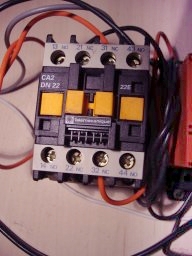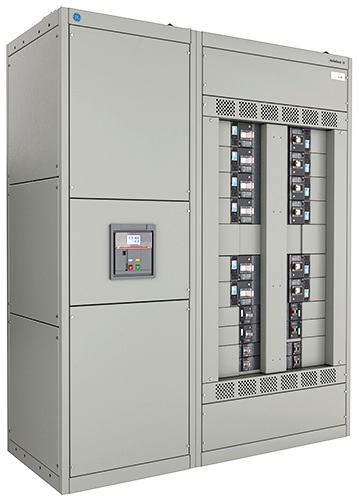|
Instabus
Instabus, is a decentralized open system to manage and control electrical devices within a facility. It is developed by Berker, Gira, Jung, Merten and Siemens AG. There are about 200 companies of electrical supplies using this communication protocol. The European Installation Bus (EIB) allows all electrical components to be interconnected through an electrical bus. Every component is able to send commands to other components, no matter where they are. A typical EIB network is made of electrical components such as switches, pulsers, electric motors, electrovalves, contactors, and sensors. This electrical bus is made of a 2x2x0,8mm twisted pair cable, that connects all devices within the network. The theoretical maximum number of components is 57375. EIB system was developed to increase power savings, security, comfort and flexibility. System control Although the EIB is a decentralized system and doesn't need any electric switchboard or control console, it's possible to implemen ... [...More Info...] [...Related Items...] OR: [Wikipedia] [Google] [Baidu] |
KNX (standard)
KNX is an open standard (see EN 50090, ISO/IEC 14543) for commercial and domestic building automation. KNX devices can manage lighting, blinds and shutters, HVAC, security systems, energy management, audio video, white goods, displays, remote control, etc. KNX evolved from three earlier standards; the European Home Systems Protocol (EHS), BatiBUS, and the European Installation Bus (EIB or Instabus). It can use twisted pair (in a tree, line or star topology), powerline, RF, or IP links . On this network, the devices form distributed applications and tight interaction is possible. This is implemented via interworking models with standardised datapoint types and objects, modelling logical device channels. KNX standard The KNX standard has been built on the OSI-based EIB communication stack extended with the physical layers, configuration modes and application experience of BatiBUS and EHS. KNX installations can use several physical communication media: * Twisted pai ... [...More Info...] [...Related Items...] OR: [Wikipedia] [Google] [Baidu] |
Siemens AG
Siemens AG ( ) is a German multinational conglomerate corporation and the largest industrial manufacturing company in Europe headquartered in Munich with branch offices abroad. The principal divisions of the corporation are ''Industry'', ''Energy'', ''Healthcare'' (Siemens Healthineers), and ''Infrastructure & Cities'', which represent the main activities of the corporation. The corporation is a prominent maker of medical diagnostics equipment and its medical health-care division, which generates about 12 percent of the corporation's total sales, is its second-most profitable unit, after the industrial automation division. In this area, it is regarded as a pioneer and the company with the highest revenue in the world. The corporation is a component of the Euro Stoxx 50 stock market index. Siemens and its subsidiaries employ approximately 303,000 people worldwide and reported global revenue of around €62 billion in 2021 according to its earnings release. History 1847 to 1 ... [...More Info...] [...Related Items...] OR: [Wikipedia] [Google] [Baidu] |
Bus (computing)
In computer architecture, a bus (shortened form of the Latin '' omnibus'', and historically also called data highway or databus) is a communication system that transfers data between components inside a computer, or between computers. This expression covers all related hardware components (wire, optical fiber, etc.) and software, including communication protocols. Early computer buses were parallel electrical wires with multiple hardware connections, but the term is now used for any physical arrangement that provides the same logical function as a parallel electrical busbar. Modern computer buses can use both parallel and bit serial connections, and can be wired in either a multidrop (electrical parallel) or daisy chain topology, or connected by switched hubs, as in the case of Universal Serial Bus (USB). Background and nomenclature Computer systems generally consist of three main parts: * The central processing unit (CPU) that processes data, * The memory that holds the p ... [...More Info...] [...Related Items...] OR: [Wikipedia] [Google] [Baidu] |
Switches
In electrical engineering, a switch is an electrical component that can disconnect or connect the conducting path in an electrical circuit, interrupting the electric current or diverting it from one conductor to another. The most common type of switch is an electromechanical device consisting of one or more sets of movable electrical contacts connected to external circuits. When a pair of contacts is touching current can pass between them, while when the contacts are separated no current can flow. Switches are made in many different configurations; they may have multiple sets of contacts controlled by the same knob or actuator, and the contacts may operate simultaneously, sequentially, or alternately. A switch may be operated manually, for example, a light switch or a keyboard button, or may function as a sensing element to sense the position of a machine part, liquid level, pressure, or temperature, such as a thermostat. Many specialized forms exist, such as the toggle switch, ... [...More Info...] [...Related Items...] OR: [Wikipedia] [Google] [Baidu] |
Electric Motor
An electric motor is an Electric machine, electrical machine that converts electrical energy into mechanical energy. Most electric motors operate through the interaction between the motor's magnetic field and electric current in a Electromagnetic coil, wire winding to generate force in the form of torque applied on the motor's shaft. An electric generator is mechanically identical to an electric motor, but operates with a reversed flow of power, converting mechanical energy into electrical energy. Electric motors can be powered by direct current (DC) sources, such as from batteries, or rectifiers, or by alternating current (AC) sources, such as a power grid, Inverter (electrical), inverters or electrical generators. Electric motors may be classified by considerations such as power source type, construction, application and type of motion output. They can be powered by AC or DC, be Brushed motor, brushed or Brushless motor, brushless, single-phase, Two-phase electric power, two-p ... [...More Info...] [...Related Items...] OR: [Wikipedia] [Google] [Baidu] |
Contactors
:''In semiconductor testing, contactors can also be referred to as the specialized socket that connects the device under test.'' :''In process industries, a contactor is a vessel where two streams interact, for example, air and liquid. See Gas-liquid contactor.'' A contactor is an electrically-controlled switch used for switching an electrical power circuit. A contactor is typically controlled by a circuit which has a much lower power level than the switched circuit, such as a 24-volt coil electromagnet controlling a 230-volt motor switch. Unlike general-purpose relays, contactors are designed to be directly connected to high-current load devices. Relays tend to be of lower capacity and are usually designed for both ''normally closed'' and ''normally open'' applications. Devices switching more than 15 amperes or in circuits rated more than a few kilowatts are usually called contactors. Apart from optional auxiliary low-current contacts, contactors are almost exclusively fitte ... [...More Info...] [...Related Items...] OR: [Wikipedia] [Google] [Baidu] |
Sensors
A sensor is a device that produces an output signal for the purpose of sensing a physical phenomenon. In the broadest definition, a sensor is a device, module, machine, or subsystem that detects events or changes in its environment and sends the information to other electronics, frequently a computer processor. Sensors are always used with other electronics. Sensors are used in everyday objects such as touch-sensitive elevator buttons (tactile sensor) and lamps which dim or brighten by touching the base, and in innumerable applications of which most people are never aware. With advances in micromachinery and easy-to-use microcontroller platforms, the uses of sensors have expanded beyond the traditional fields of temperature, pressure and flow measurement, for example into MARG sensors. Analog sensors such as potentiometers and force-sensing resistors are still widely used. Their applications include manufacturing and machinery, airplanes and aerospace, cars, medicine, robot ... [...More Info...] [...Related Items...] OR: [Wikipedia] [Google] [Baidu] |
Twisted Pair
Twisted pair cabling is a type of wiring used for communications in which two conductors of a single circuit are twisted together for the purposes of improving electromagnetic compatibility. Compared to a single conductor or an untwisted balanced pair, a twisted pair reduces electromagnetic radiation from the pair and crosstalk between neighboring pairs and improves rejection of external electromagnetic interference. It was invented by Alexander Graham Bell. For additional noise immunity, twisted-pair cabling may be shielded. Cable with shielding is known as shielded twisted pair (STP) and without as unshielded twisted pair (UTP). Explanation A twisted pair can be used as a balanced line, which as part of a balanced circuit can greatly reduce the effect of noise currents induced on the line by coupling of electric or magnetic fields. The idea is that the currents induced in each of the two wires are very nearly equal. The twisting ensures that the two wires are on ave ... [...More Info...] [...Related Items...] OR: [Wikipedia] [Google] [Baidu] |
Electric Switchboard
An electric switchboard is a device that distributes electricity from one or more sources of supply to several smaller load circuits. It is an assembly of one or more panels, each of which contains switching devices for the protection and control of circuits fed from the switchboard. Several manufacturers make switchboards used in industry, commercial buildings, telecommunication facilities, oil and gas plants, data centers, health care, and other buildings, and onboard large ships. A switchboard is divided into different interconnected sections, generally consisting of a main section and a distribution section. These two sections are sometimes replaced by a combination section, which is a section that can fulfill the roles of both aforementioned sections. Switchboards can also sometimes come with an auxiliary section that is used to house devices that cannot be housed in the same section as other devices. Definition The U.S. National Electrical Code (NEC) defines a switchboard ... [...More Info...] [...Related Items...] OR: [Wikipedia] [Google] [Baidu] |
Building Automation
Building automation (BAS), also known as building management system (BMS) or building energy management system (BEMS), is the automatic centralized control of a building's HVAC (heating, ventilation and air conditioning), electrical, lighting, shading, Access Control, Security Systems, and other interrelated systems. Some objectives of building automation are improved occupant comfort, efficient operation of building systems, reduction in energy consumption, reduced operating and maintaining costs and increased security. BAS functionality may keep a buildings climate within a specified range, provide light to rooms based on an occupancy, monitor performance and device failures, and provide malfunction alarms to building maintenance staff. A BAS works to reduce building energy and maintenance costs compared to a non-controlled building. Most commercial, institutional, and industrial buildings built after 2000 include a BAS, whilst older buildings may be retrofitted with a new ... [...More Info...] [...Related Items...] OR: [Wikipedia] [Google] [Baidu] |
Home Automation
Home automation or domotics is building automation for a home, called a smart home or smart house. A home automation system will monitor and/or control home attributes such as lighting, climate, entertainment systems, and appliances. It may also include home security such as access control and alarm systems. When connected with the Internet, home devices are an important constituent of the Internet of Things ("IoT"). A home automation system typically connects controlled devices to a central smart home hub (sometimes called a " gateway"). The user interface for control of the system uses either wall-mounted terminals, tablet or desktop computers, a mobile phone application, or a Web interface that may also be accessible off-site through the Internet. While there are many competing vendors, there are increasing efforts towards open source systems. However, there are issues with the current state of home automation including a lack of standardized security measures and dep ... [...More Info...] [...Related Items...] OR: [Wikipedia] [Google] [Baidu] |







